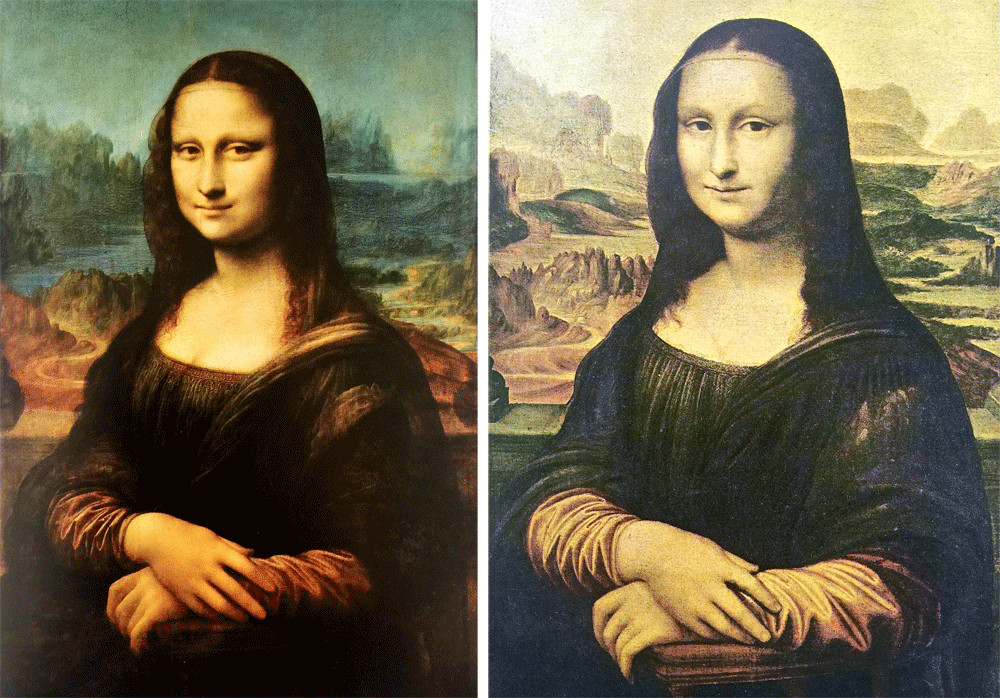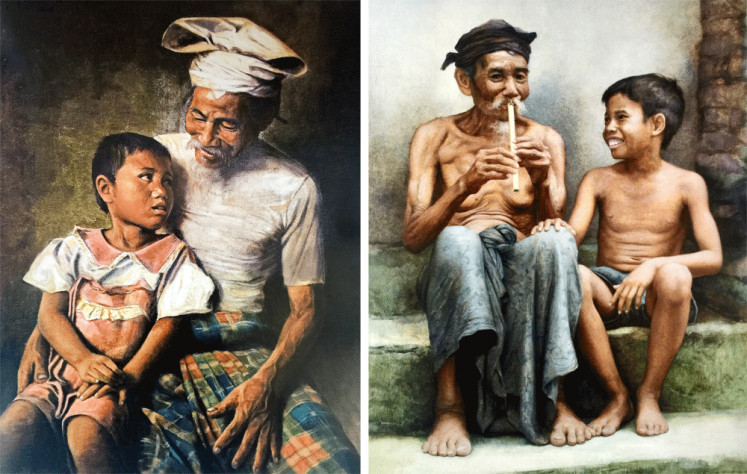The art of reproducing paintings
Change Size
 Different tones: Leonardo da Vinci’s Mona Lisa (left) and a reproduced version by Bernadino Luini. (-/Agus Dermawan T.)
Different tones: Leonardo da Vinci’s Mona Lisa (left) and a reproduced version by Bernadino Luini. (-/Agus Dermawan T.)
Amid frequent painting forgery, a respectable enterprise called reproducing has emerged as a counter movement.
The phenomenon was displayed during the launch of book by the Indonesian Fine Art Lovers Association (PPSI), titled Melacak Lukisan Palsu (Tracing Fake Paintings), at the Ciputra Artpreneur in Jakarta.
Edited by Syakieb Sungkar, Seno Joko Suyono and Wicaksono Adi, the 242-page book is the latest update after Indonesian Painting Forgery ( 2016 ) and Jejak Lukisan Palsu (Traces of Forged Paintings, 2014).
Dozens of paintings were displayed on the occasion, under the curatorial title of “Maestros and Their Disciples”. It was an interesting exhibition because of the courage to present the reality of “adherence” in an honest manner. In fact, the painters have always felt they are “original”.
This reality of “adherence” is something that has been constant through the ages, leading to patronage.
Jacopo Bellini, for example, led to the emergence of many disciples in Italy, Rembrandt van Rijn in the Netherlands, Diego Velazquez in Spain, William Turner in Britain and Picasso in the whole world.
In Indonesia, Affandi gave rise to many disciples from Kartika and Rukmini to Men Sagan and JB Iwan Sulistyo. Lee Man Fong has had such disciples as Lee Rern and Cheng Sui.
Abstract painter Ahmad Sadali has been followed by Umi Daclan and Tintin, and Dullah by Kok Poo, Inanta and a dozen more. This is in spite of the fact that the disciples have finally become independent and boast their existence with their respective standpoints of just “following in the maestros’ footsteps” or “only being influenced”.
In the classical fine art discourse the reference as disciples is a respectable one for those regarded as having their own position.
At the Louvre Museum in Paris, Hermitage Museum in St Petersburg, Rijksmuseum in Amsterdam, Prado in Madrid, tens of thousands of paintings on display are the works of disciples, who have followed in the footsteps of a number of icons called “True Creators”. Without the disciples’ canvases there would be few major museums.
The Unesco Courier journal has for 30 years always asserted that galleries in Europe are indeed accentuated by the iconic masterpieces of True Creators but the breath of life inside them as well as as the public space is filled by the thousands of works of disciples.
History has given examples of the position of disciples.
The works of Frans Hals (1582 to 1666) are displayed in Harlem, Holland and they are accompanied by the paintings of his children; Harmen, Jan, Reinier and Nicolaes. These paintings are precisely the same as those of Frans.
The works of Pieter van Roestraen, who is Frans’ younger brother-in-law, are also similar to those of Frans. The reality of the regenerated style has become the Dutch art community’s special pride, such that the image of Frans Hals is emblazoned on the Dutch guilder.
The same is true in the Balinese traditional painting art discourse.

The lighting style of Walter Spies’ paintings inspired I Gusti Agung Wiranata, Ni Gusti Agung Galuh, I Gusti Agung Kepakisan and Ni Gusti Agung Monalisa. None of them has denied this adherence. Critics and the market have later also wholeheartedly recognized this.
However, not only disciples, but reproducers also legitimately deserve their place.
During the 1970s in Paris, there was an artist named Antonio Bin and he was a very popular reproducer of Leonardo da Vinci’s Mona Lisa.
Bin was said to be capable of imitating the Mona Lisa down to its details. After finishing 1,000 Mona Lisa paintings, all selling for around US$2,000, the name of Bin entered the Guinness World Records in 1980.
Literary man and philosopher Johann Wolfgang von Goethe once said, “A painter, although imitating, remains a creator.”
Therefore, the works of reproducers always deserve special appreciation. This is why several international auction houses, including Christie’s, have opened auctions entitled “Copies After Old Master Pictures”. The reproduced works have been sold for tens of thousands of dollars per piece.
The appreciation for imitated pictures has continued.
In 1984 in Italy, the Fondazione dei Falsi d’Autore, a foundation managing reproducing specialists, was set up. This institution was led by Prof. Daniele Ermes Donde. Expert reproducers gathered and were grouped according to their specializations. Their works were later taken around the world under the banner of promoter Le Musee Imaginaire with the label “Imitation Paintings”.
The market for reproduced works is remarkable.
Those who have no chance of owning original paintings need not be ashamed of possessing their imitations, as long as they are of special quality.
Elizabeth Taylor, Frank Sinatra, Roger Moore, Arnold Schwarzenegger and the Monegasque royal family have collected reproduced images. Indonesia has also once been visited by a group with such imitations. A number of Indonesian collectors enthusiastically welcomed them.
Another thing worthy of note in the context of reproduced works is that the canvases have no imitations of the signatures of their original painters. The backs of the pictures even bear stamps affirming that they are “Painting Copies”. The moral message of these imitated paintings seems noble: Never be forgers, be reproducers.









